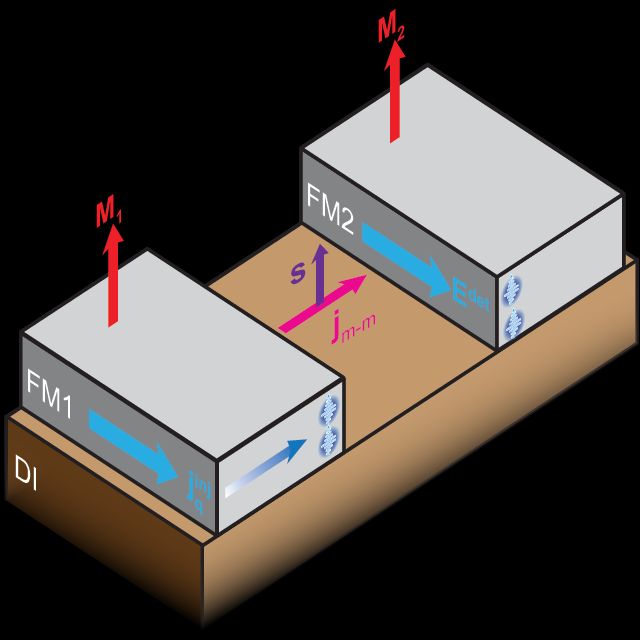
Magnons bridge the gap
Electrically Induced Angular Momentum Flow between Separated Ferromagnets.
A team of researchers from the Bavarian Academy of Sciences and Humanities (BAdW), the Technical University of Munich (TUM), the ETH Zürich, the University of Konstanz and the Universidad Autónoma de Madrid (UAM) has demonstrated the transfer of spin information between two separated ferromagnetic metal strips harnessing magnetic excitations, providing a new avenue for spintronics.
Exploring efficient and fast ways to process and transport information is of key importance to improve current information technologies. Information can be transferred not only by electrons or photons but also by other particles. One promising carrier of information is the spin angular momentum. In real materials, there is a complex interplay between different particles, allowing the exchange of spin information. In a collaborative research effort, a novel scheme to exchange spin information was established, allowing to unravel these interactions and thus venture into a new direction for spin information transport.
Today, information is encoded and transported mostly by carriers, such as electrons and photons. Whereas photons dominate communication systems, electrons do so in information-processing devices. Besides its charge, electrons also possess spin. This spin is an intrinsic property representing angular momentum, which can assume two discrete states along a quantization axis, making it ideal for binary information encoding. The spin and its associated magnetic moment are routinely exploited in a steadily growing field of information technology called spintronics. Well-known examples are non-volatile magnetic random-access memories or magnetic storage systems.
Using electrons for spin transport is not the only option. In magnetically ordered materials, such as ferromagnets or antiferromagnets, spin can be carried by excitations of the spin lattice, called magnons or spinwaves, without any associated charge transport. In a metallic magnetically ordered material, electrons, phonons, and magnons interact with each other such that angular momentum can be transferred between these entities. Present spintronic device designs rely only on using the electron spin information. Improving these device schemes and making spintronic devices more versatile requires a complete understanding of the angular momentum transfer. Thus, experiments to unravel the intricate interaction of mobile electrons and magnons are crucial for future spintronic applications.
Transfer of spin information between two isolated magnets
Relying on spin-orbit interaction, which makes the electron motion spin-dependent, one can generate an electronic spin current by applying a charge current to an electrical conductor. If the conductor is magnetically ordered, the electronic spin current transfers spin to the magnons, leading to an additional magnon spin current. To distinguish the electronic and magnonics spin currents, special experimental techniques only sensitive to one of the two entities are needed.
One possible approach is to realize a scenario where only magnons can contribute to the spin transport, while electrons cannot. Such a situation provides an interesting new perspective for future applications and gives insight into the special interplay between the different carriers of spin information, particularly how spin is transferred from one to another. Joint research efforts by scientists from the Walther-Meißner-Institute (WMI) of BAdW and TUM, the ETH Zürich, the University of Konstanz, and the UAM have successfully revealed the spin current transport between two electrically isolated ferromagnetic thin film metal strips. In the employed geometry, magnons can bridge the gap between the two ferromagnets via their associated time-varying magnetic field. A charge current is applied to one ferromagnetic strip, and the resulting magnon spin current then transfers to the second ferromagnet strip. The reversed process detects the transferred magnon spin current in the second ferromagnetic metal strip as an electrical current. Dr. Richard Schlitz, the first author of the publication, is excited about the potential of the discovery: “Our experimental observation is really surprising and required careful further tests to identify the origin. We now have a tool available that provides access to the magnon spin information transport in magnetically ordered conductors via simple electrical transport measurements. In addition, we use this tool to understand the details of the spin information transfer between electrons and magnons.”
An important part of the collaboration was establishing the theoretical basis for interpreting the experiments. Dr. Matthias Althammer, leading the joint research effort, says: “The experimental results can be understood by considering the device geometry in comparison to the length scales of spin transport via electrons and magnons. While the stray field associated with the magnons seems to be the dominant contribution, we are still in the early stages of unraveling all the details. We are confident that our experiments will spark further developments in the field of spintronics.”
Publication:
Electrically Induced Angular Momentum Flow between Separated Ferromagnets
R. Schlitz, M. Grammer, T. Wimmer, J. Gückelhorn, L. Flacke, S.T.B. Goennenwein, R. Gross, H. Huebl, A. Kamra, M. Althammer,
Physical Review Letters 132, 256701 (2024)
doi: 10.1103/PhysRevLett.132.256701
Acknowledgements:
This work has been supported by the Deutsche Forschungsgemeinschaft under Germany’s Excellence Strategy (EXC-2111 – 390814868) and the Collaborative Research Centers 360, and SFB 1432 – Project-ID 425217212, as well as by the Spanish Ministry for Science and Innovation (AEI Grant CEX2018-000805-M) through the “Maria de Maeztu” Programme for Units of Excellence in R&D. This research is part of the Munich Quantum Valley, which is supported by the Bavarian state government with funds from the Hightech Agenda Bayern Plus.
Contact:
PD Dr. Matthias Althammer, PD Dr. Hans Huebl, Prof. Dr. Rudolf Gross
Walther-Meißner-Institut
Bayerische Akademie der Wissenschaften & Technische Universität München
Walther-Meißner-Straße 8
D-85748 Garching
Dr. Richard Schlitz, Prof. Dr. Sebastian T.B. Goennenwein
Physik Department
Universität Konstanz
D-78457 Konstanz
Dr. Akashdeep Kamra
IFIMAC - Condensed Matter Physics Center
Universidad Autónoma de Madrid
Francisco Tomás y Valiente 7
E-28049 Madrid
